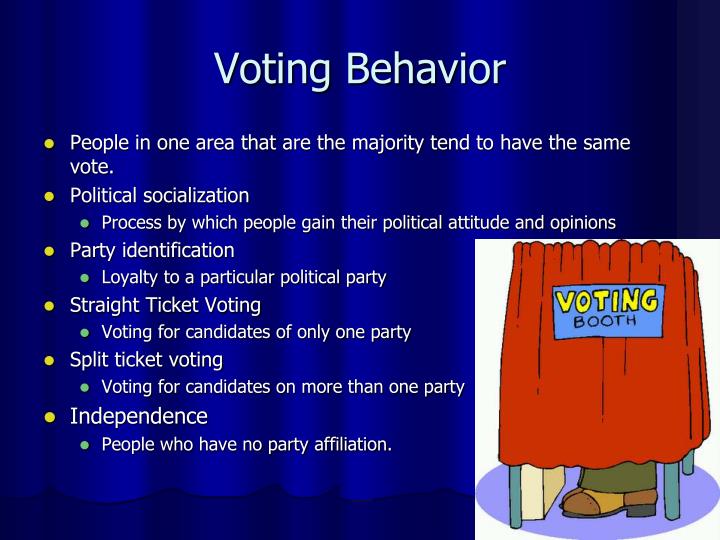

A 2000 research study on partisanship voting in the United States found evidence that partisan voting has a large effect on voting behavior. Partisan voting is also an important motive behind an individual's vote and can influence voting behavior. Partisanship Ģ016 Election in Japan A 1960 study of postwar Japan found that citizens living in urban areas were more likely to be supportive of socialist or progressive parties, while citizens living in rural areas were favorable of conservative parties. Voting behavior for referendums differs slightly, as people vote for or against a clearly defined policy. In local and regional elections, voters tend to vote for those who seem more capable to contribute to their area. In national elections, voters usually vote based on their political ideologies. Citizens use different decision criteria if they are called to exercise their right to vote in presidential, legislative, local elections or in a referendum. Research following the Cypriot Referendum of 2004 identified four distinct voting behaviors depending on the election type. Each factor has a different level of importance and influence on one's vote dependent on the country one is voting in. These factors also tend to hold different levels of weight in different countries, based on their political environment, meaning that there is no universal explanation for voting cleavage in all democratic countries. Many cleavage-based voting behaviors are interconnected and frequently build on each other. The influences of class voting is reliant on political environment and location, many nations observe the opposite preferences. Traditional conceptions of class voting dictate a working-class preference towards left-leaning parties and middle-class preference for right-leaning parties. In recent years, voting cleavage has shifted from concerns of Protestant vs Catholic religions to have a larger focus on religious vs non-religious leanings. Three cleavage-based voting factors, or individual differences impacting voting behavior, focused on in existing research are religion, class, and gender. The information provided to the voter, not only influences who to vote for, but if they are intending to at all. Additionally, the information supplied to the voter is significant in understanding voting behavior.

Thus, if there is high voter satisfaction in how the political party performed, then the likelihood of a reoccurring vote in the next election is high.


There is a correlation between voter satisfaction with what a political party has achieved and dealt with a situation and voters' intention of voting for the same party again. Voter behavior is often influenced by voter loyalty. Voting advice applications and avoidance of wasted votes through strategic voting can impact voting behavior. Voter decision-making is not a purely rational endeavor but rather is profoundly influenced by personal and social biases and deeply held beliefs as well as characteristics such as personality, memory, emotions, and other psychological factors. The degree to which a person identifies with a political party influences voting behavior, as does social identity. Social factors include race, religion and degree of religiosity, social and economic class, educational level, regional characteristics, and gender. Voter attitudes include characteristics such as ideological predisposition, party identity, degree of satisfaction with the existing government, public policy leanings, and feelings about a candidate's personality traits. This decision is shaped by a complex interplay between an individual voter's attitudes as well as social factors.
Voting blocs and behaviors definition ap gov how to#
Voting behavior refers to how people decide how to vote.


 0 kommentar(er)
0 kommentar(er)
